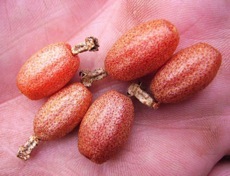Edible Elaeagnus
First it was “poisonous.” Then it was “not edible.” Later it was edible but “not worth eating.” Actually, it’s not toxic but tasty, and easy to identify. It makes one wonder how some plants get so maligned.
The Silverthorn, Elaeagnus pungens, came from China and Japan to North America some 200 years ago in the early 1800’s. It’s an ornamental landscape plant often used for hedges and barriers. The Silverthorn is also closely related to the Autumn Olive and Russian Olive, both of which have edible fruit as well (E. umbellata, E. angustifolia.)
Perhaps the bad-mouthing also comes from the fact the Silverthorn has escaped cultivation. The shrub is found from Virginia south to Florida and west to Texas. It is also found at Smith College in Northampton, Massachusetts. Florida lists it as a Category II invasive exotic species. Seems to me the only civic thing to do is eat the weeds.
Evergreen, the Silverthorn is also called the Thorny Olive and the Thorny Silverberry. It blooms
around October and has edible fruit about February. Authors’ opinions on the berry, actually a fruit, range from toxic to edible but lousy. I find them sweet and tart at the same time, and very much worth eating. But you do have to get them ripe or they can be astringent. I have also reached the conclusion that folks who write books on landscaping actually hate the plants they write about. Personally, I look forward to Silverthorn season every year. Better, it fruits in the middle of our winter. Few plants do.
From a nutritional point of view the Elaeagnus has 17 times the lycopene than tomatoes. Yes, 17 times more. The edible seed has fiber and omega 3 fatty acids but is on the bitter side. One can also eat the seed shell but I prefer not to. The plant is a nitrogen fixers which means it can grow in poor soil and provide nitrogen for other plants.
As for the common names, the bush does not really have thorns but rather sharp twigs that grow into branches. The berry-like fruit is red and silver/gold (from a distance it looks like red and silver but up close red and gold.) The botanical name is a mixed menu. Pungens (PUN-jenz) is easy. It means sharp or pointed. Reminds me of the punji sticks used in Vietnam. Elaeagnus is a bit of an amalgamation and Latinized Greek. It means “Sacred Olive.” Elaia = olive tree, agnos = sacred. Why the genus was named that is anyone’s guess.
Also edible are the fruits of the E. commutata, which is native to North America. Alaskan natives fried them in Moose fat. E. multiflora, the climbing E. philippensis, and E. latifolia are also edible, the latter often cooked and or made into a compote. Many Elaeganus in their native range elsewhere in the world have edible fruit. The seed is also edible on E. umbellata. The genus is closely related to the Sea Buckthorn. (See separate entry.)
The Elaeagnus clan was championed at one time by various official and unofficial plant groups as good for land and animal. Song birds in particular like the fruit. Turkeys, hens and bears do,too. But in recent years opinions have changed and now it is view as a competitor for native species and is on several states’ hit list. I’ve only seen it under cultivation.
Elaeagnus fruit has numerous uses. It can be eaten out of hand though they tend to be astringent if picked too early. It can easily be made into fruit leather, juice, jam and jelly. You can freeze the juice and use it in yogurt or to make a tea. The fruit can be dehydrated as well. Several species have edible seeds. I usually eat the kernel and toss away the hull.
Green Deane’s “Itemized” Plant Profile
IDENTIFICATION: Shrub 3 to 25 feet, leaves are lance-shaped, evergreen, simple or wavy edges, 2 to 4 inches long. Upper leaf surface is waxy green, often scaly. Lower leaf surface are silvery and scaly with brown dots. The leaves feel tough and grainy. Young branches on branches are thorny. The Fruit can be red to red with silver or gold glitter. The seed covering has longitudinal ridges.
TIME OF YEAR: Blossoms in fall, fruits in early spring. (The Autumn Olive fruits generally in late summer or fall.)
ENVIRONMENT: Full sun is preferred and good soil but it can grow in partial shade and poor soil
METHOD OF PREPARATION: Usually eaten out of hand. Can be made into jam, jelly, fruit leather, juice can also be used to make tea or flavor yogurt. Seed kernel is edible.






